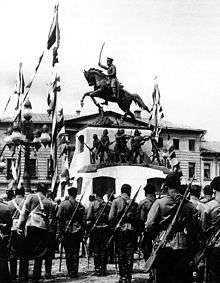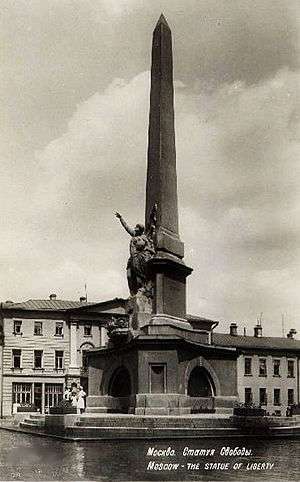Statue of Yuriy Dolgorukiy, Moscow
| Statue of Yuriy Dolgorukiy in Moscow | |
|---|---|
.jpg) Statue of Yuriy Dolgorukiy, Moscow, 29 June 1966. | |
| Artist | S. Orlov, A. Antropov, N. Shtamm, V. Andreyev |
| Year | 1954 |
| Type | Bronze statue |
| Location | Tverskaya Square, Moscow |
The Statue of Yuriy Dolgorukiy is an equestrian statue which commemorates the founding of Moscow in 1147 by Yuriy Dolgorukiy (1099 – 1157). Dolgorukiy was the Grand Prince (Velikiy Knyaz) of the Kievan Rus' (Kiev) and a member of the Rurik dynasty. On 6 June 1954, the statue was erected in Tverskaya Square (then called "Soviet Square"), located in front of the building of the Moscow Mayor (then, the "Mossovet"). The sculptors were Sergei Mikhailovich Orlov, A. P. Antropov, and Nicholay Lvovich Shtamm. The architectural design was by Viktor Semenovich Andreyev. The statue replaced one of the general, Mikhail Skobelev.
Skobelev statue




The original statue erected in 1912 in Tverskaya Square was of General Mikhail Skobelev, a hero of the Russian-Turkish War of 1877. Skobelev was shown mounted his horse. The monument was known as "The White General". Skobelev wore a white parade tunic and rode a white horse into battle. He was also a member of the Tsar's military force and therefore a "White".
Following the October Revolution of 1917, a decree concerning monuments "erected in honour of tzars and their servants" was issued. It was part of Lenin's campaign of propaganda through monuments. Because of this decree, the Skobelev monument was removed.
Constitution obelisk
In 1918, the Skobelev monument was replaced by the Constitution obelisk.[1] The 26 metres (85 ft) high, three-edged Constitution obelisk built in honour of the Soviet constitution, was erected in front of the Mossovet.
In June 1919, the obelisk was joined by a Statue of Liberty. It was created by the sculptor, Nikolay Andreyevich Andreyev. Vera Alekseyeva, the niece of Konstantin Stanislavski, might have posed for this statue.[2] Another possible model was the actress at МХАТ, Eugenie Khovanskaya, who was famous for her beauty.[3] The sculptor was inspired by the dynamic forms of classical Greek statues such as Nike of Samothrace.
The Constitution obelisk did not stand for long. By the end of the 1930s, it required complete restoration. It had been hastily and cheaply made from low grade materials; the obelisk was built in brick and plastered "like granite". The statue was cast in concrete. On 22 April 1941, before it could be restored, the monument was blown up and removed. The head of the Statue of Liberty survived and was placed in the Tretyakov Gallery [3]
Creation of the statue
A settlement had existed at the site of Moscow at least 200 years prior to its official founding in 1147 by Yuriy Dolgorukiy. However, the 800th anniversary of Moscow celebrations in September 1947 accepted the traditional date. This first large, post-war celebration, shortly preceded the 30th anniversary celebrations of the October Revolution.
In 1946, Joseph Vissarionovich Stalin sent the archaeologist and anthropologist Mikhail Mikhaylovich Gerasimov (1907 – 1970) from Kiev to find remains of Yuriy Dolgoruky. This was so that a ceremonious reburial of Dolgoruky could take place during the celebrations. No remains were found at Dolgoruky's grave.
In September 1946, a competition to design the Dolgorukiy monument was held. The sculptor S.M. Orlov won the competition and was awarded the Stalin Prize for his work. The Russian writer, journalist, and historian Alexander Anatoliyevich Vas'kin said that Stalin selected Orlov's entry from amongst the other entries because it was praised by the American ambassador W. Averell Harriman (1891 – 1986) during a Moscow Kremlin reception.[4]
On 6 September, 1947, the groundbreaking ceremony for the monument took place during the celebrations. However, the monument took some time to build. Disagreements took place between the three artists. The scale of Orlov's design and technique's were questioned. His usual small sculpture techniques might not have worked on a monumental work.
Orlov also clashed with authorities. He opposed to the text on the monument dedication, reading, "To the founder of Moscow from the Soviet government". (The Soviet government is not mentioned on the monument.)[1] Insufficient funding also affected the speed of work. Moscow's anniversary marked the simultaneous launches of several large-scale projects all of which required special funding. These included the building of the "Stalin skyscrapers".
A possibly apocryphal story tells of Stalin's approval of the final version of the monument. He carefully considered the model and said, "Why do you, Comrade Orlov, have Dolgorukiy sit on the mare? A stallion can accentuate the masculinity of the founder of Moscow". Changes were introduced to the project immediately.[2][5]
The sculpture was produced by the "Mytishchi Plant in honour of the national artist E. F. Belashova". The production was supervised by the sculptor and bronze caster Savinsky Gabriel Ivanovich. It cost 5.5 million roubles paid by the city of Moscow. The grand opening of the monument took place on 6 June, 1954.
Reception
The public reacted negatively to the government's building of the Dolgorukiy monument. The monument did not reflect the ideology of the Communist Party.[6] Dolgorukiy was considered an "exploiter of the peasantry and the tax collector of the feudal system".[7]
At the unveiling of the statue, the writer, Zinovy Samoylovich Papernov said, "It is not a good likeness". The composer, Sigizmund Abramovich Kats said, "It is a good likeness".[8]
References
- 1 2 Title: Всегда и во всём быть художником. Publisher: Мир истории. Published in January, 2002. Accessdate: 2009-02-08. Language: Russian.
- 1 2 "Всадники и Статуя Свободы на Тверской площади". Москва. Назад в будущее. Что было — что стало. RetroMoscow. Archived from the original on 2012-03-19. Retrieved 2009-02-08.
- 1 2 Беляева, Екатерина (2006-10-28). "Москва потеряла свободу". МК-Суббота. Archived from the original on 2007-05-18.
- ↑ Author: Васькин, Александр. Title: Тверская улица в домах и лицах. Published by Центрполиграф, Moscow, date 2015. Total pages: 236.
- ↑ "7 сентября в истории". NewsInfo. Published on 7 of September, 2008. Archived from the original on 2012-03-19. Retrieved 2009-02-08.
- ↑ Тонкости Туризма >> Памятник Юрию Долгорукому в Москве
- ↑ Прогулки по Москве >> Памятник Юрию Долгорукому
- ↑ Author: Алексей Митрофанов. Title: Прогулки по старой Москве. Тверская. Publisher: Ключ-С, Moscow. Date 2006. ISBN 5-93136-024-7
See also
| Wikimedia Commons has media related to Monument to Yuri Dolgorukiy in Moscow. |